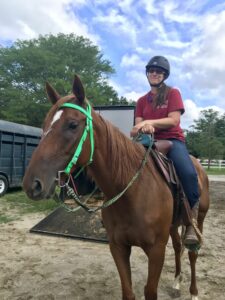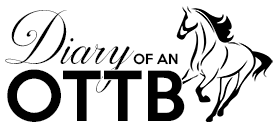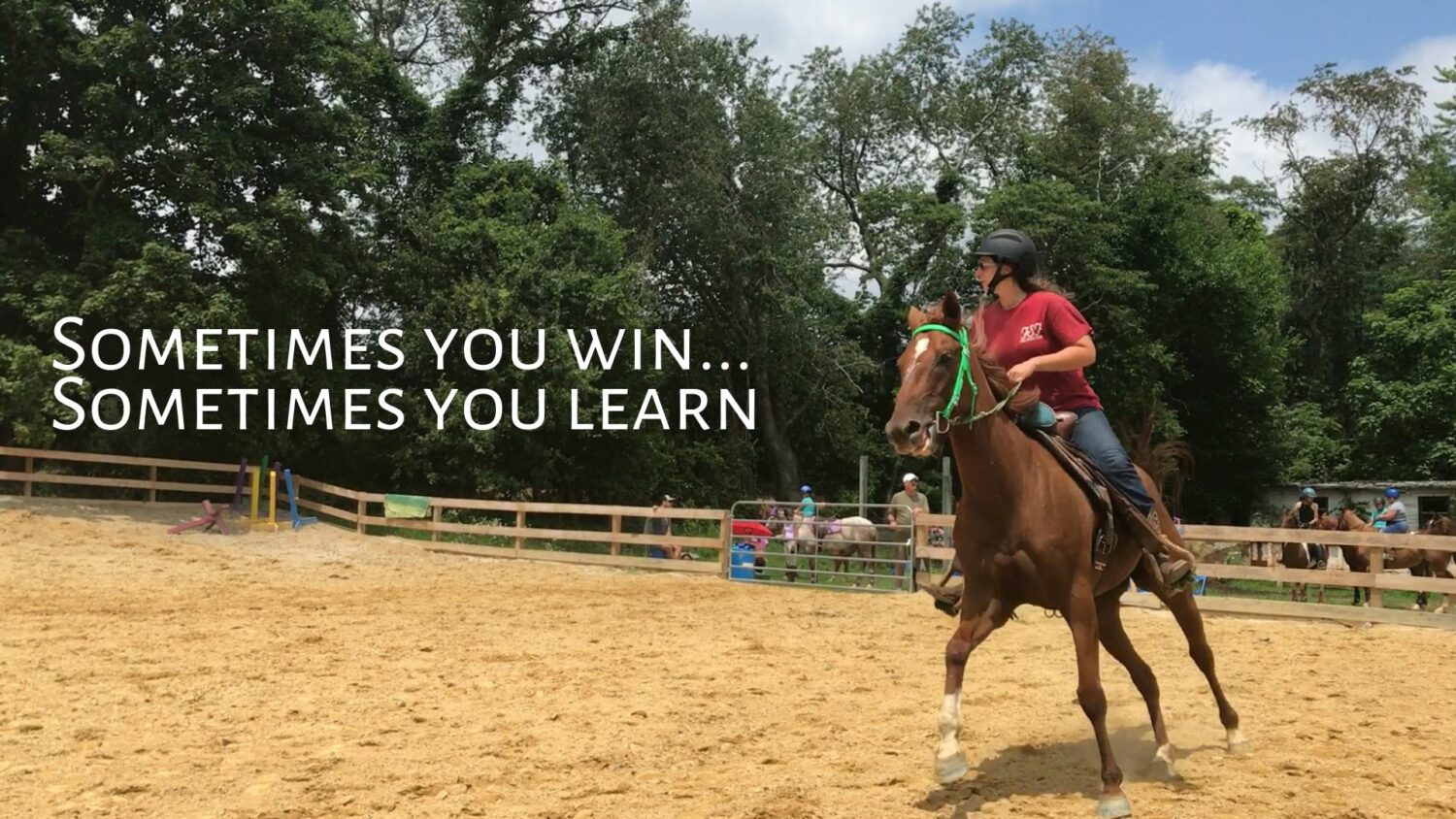Horse shows. Ah yes. Days that are often filled with anxiety, frustration, more anxiety, and the always enjoyable game of hurry-up-and-wait that seems to accompany every horse show under the sun, regardless of whether you’re competing in English or Western events.
But taking a retired racehorse to its first show can be an even more complicated endeavor since this is probably an entirely new experience for them. Retired racehorses are no different than other young or uneducated horses. But in order to give a young or green horse the best first show experience possible there are a few things you can do to before to help prepare you both and a some tips to keep in mind to help avoid frustration when you’re there.
Preparing Your OTTB For the First Show

I talked to Lisa, my fiancee who recently took her 6-year old OTTB, a granddaughter of Pulpit named Red Spots (aka Cali), to her first show this past weekend. We chatted about some of the things she did to get her and Cali ready for the show.
Basic Desensitizing
While it’s certainly not true for every racehorse, many of them have been exposed to things like large crowds, music, and even flapping banners and signs by virtue of being at the track. This does not mean that every racehorse will have no issue with things like tarps or loud speakers at your first show. Basic desensitizing can and should absolutely be something you practice before going anywhere. You can use tarps, plywood on the ground, your own music, cones, cars, lawnmowers, and just about anything that makes sound or looks a little scary to help simulate a day at the horse show. But let’s be perfectly honest here: nothing will totally simulate that first show. Between trailering off property and all of the unfamiliar people and horses around, doing some basic desensitizing is an excellent way of hedging your bets but by no means a guarantee that you’ll be taking a bomb proof racehorse with you to your first show.
Focus on Communication, Rhythm & Respect
Retraining a racehorse is difficult and not all of them come together quickly. Don’t worry about this if your ambitions are to get to a show! Instead, focus your training efforts on clear communication, rhythm, and respect. If you can continuously communicate with respect, you’ll put yourself in a better position to maintain your rhythm and handle some potentially frustrating moments with a young horse at your first show. Under saddle, developing a steady rhythm at each gate will help give you a solid foundation for anything that might happen off-property. You’ll want to continuously revisit and search for a steady rhythm regardless of how quickly you might be navigating a pattern so you can better reinforce that communication and respect that you work on at home.
Practice Trailering, Loading & Off-Loading
Try your best to avoid having your first trailering experience be on the morning of a show. While this applies to OTTBs its equally true for any horse in that you should do your horse the favor of practicing before you take them into what is a predictably chaotic environment. While many retired racehorses may have had some experience trailering, they may have traveled with friends or in large 18-wheeler trailers, which presents a very different experience than average your 2-horse bumper pull. A good way of practicing and re-introducing the concept of trailering is to walk your horse into the trailer, feed him a treat, and guide them out. After a few tries with this you’ll likely be able to close the doors and go for your first “trip” in the trailer, even if it’s as short as driving down the driveway and turning around again. Practicing trailering, loading, and off-loading in a way that’s educational for your OTTB can go a long way on show day when you’re running a few minutes late or get there way too early and end up needing to leave the horse in the trailer.
Practice the Patterns At A Trot… A LOT
Leading up to any show practicing the patterns of jumps, poles, barrels, keyhole, or a course you make up that morning, is a great way of continuously getting your horse’s attention and focus on a very clear task at hand. In order for this to be done without driving the horse bonkers or just giving them the idea that they should bolt through everything at a canter, you should ideally be doing a lot of this prep work on the pattern at a trot. Every horse can run, but can your horse walk calmly to the end? This all relates back to focusing on clear communication, rhythm, and respect. The more you have of this sort of practice, the better off you’ll be on show day.
Find a Show That’s Geared Towards Green Horses Or Allows Practice Runs
Not all horse shows are created equally. The show that Lisa took Cali to was essentially a practice gymkhana specifically for amateurs, English riders, and young horses. This made it the perfect environment to take a young, untested horse for its first taste of a show. Finding this sort of a non-judgmental environment or a show that allows practice runs affords you the opportunity to donate your dollars so your horse can benefit from the experience while you can correct mistakes as they happen without the fear of penalty or being looked down on by the local show snobs. When you can give your horse the full show experience without the demand of needing to be competitive on day one, you can correct a lot of issues as they happen and most likely prevent problems from forming at your second or third shows.
The day of The First Show
This past Sunday we woke up bright eyed and not at all bushy tailed and loaded Cali into the trailer for her first off property show. Both Lisa and Cali did great in what Lisa referred to as a day of “interpretive gymkhana” because hey, we’re measuring by our own standards, not by the time on the clock or ribbons.
Here’s a little of what you can expect at your first show, and my best line of advice: hope for the best, prepare for the worst and you’ll often be pleasantly surprised.
Do Yourself a Favor… Don’t Focus On Ribbons or Personal Best Times Your First Time Out
This might be the most critical mindset to prepare yourself with when you’re taking an OTTB to its first ever show — in a sense, you need to prepare to lose for the sake of making sure that your horse (and you) learn something. Prepare to go slower than the rest so you can focus on developing a steady rhythm, so you aren’t out of control barreling home or off pattern. These are the moments that help set your horse up for success in the long run. I asked Lisa after she trotted through the pattern whether she could have done it at a canter and she replied, “I could have pushed her through faster, but that’s just not what she needed to focus on.” This first show is less about you and more about just that — realizing what your horse needs to focus on, improve on, and what you need to work with them on to get better for the next go round. Rome wasn’t built in a day and neither was the perfect show horse.
Work With What The Horse Is Giving You
If you’re using this first show as a schooling opportunity, you’ll want to be observant enough to see what the horse is giving you and patient enough to address those issues as they come up. For example, despite practicing trailering, loading and off-loading, we arrived to the show with Cali worked up into a bit of a fit in the trailer after her buddy made his exit. At one point she tried to roll in the trailer and was met with the heavy metal bar that separates the two spaces. Had Lisa of forced Cali off the trailer in this state, then we’re already working backwards and feeding into the behavior that we’re trying to avoid. Instead, work with what the horse is giving you. Problem standing in the trailer? Let’s work on that until you’ve calmed down again and then move on. That’s exactly what happened with Cali and with a bit of ignoring she quickly figured out it was better to stand there and eat the hay from her net than to thrash around calling for her friend. When she did this we took the opportunity to calmly back her out of the trailer. Lisa applied the same logic when Cali got a bit spooky at the back of the ring and together they did their interpretation of the pattern, going an extra circle or loop, whatever she needed to regain Cali’s attention before bringing her home. After one event Lisa went so far as to back Cali out of the ring just to regain her attention.
Keep Calm And Carry On
There will probably be a time or ten when your horse might be on the verge of full-blown meltdown. It’s your job to keep calm and carry on. Do your best and be prepared to ride through the worst. Cali had a few of these baby show moments that included a range of less than desirable behaviors, like a brief bucking and rearing fit and one moment where Cali bolted and I was pretty sure both she and Lisa were going to jump straight over the fence and into the paddock with a few other ponies. They didn’t because within two strides of bolting, Lisa had a hold of Cali, bending her to the inside around and around until she softened. It’s essential that you have these sort of tools to fall back on so you can keep calm and carry on even when your horse is refusing to. It’s your job to coach them through and turn it into a positive learning experience.
Celebrate the Small Victories
Along with the keep calm and carry on attitude, look for every area of improvement down to the smallest victories… and celebrate them. It’s finding these bits of progress that will help keep you motivated even during the most frustrating first shows. Every bit of this success is a ribbon unto itself, it’s just up to you to feel that victory. The ribbons will come with time and practice, but the feeling of satisfaction you’ll get from successfully taking your horse out for the first time will put all of that to shame.


My OTTB and I both had our first show a couple of weeks ago. It was a combined training event outside of St Louis, she did great . We got eliminated on cross country because I lost track of offense but could not be happier with how she handled the chaos and the event. Going back for seconds in November. Wanda’s Secret, Vicar daughter.